It only makes sense. Sunlight heats a comet and causes ice to vaporize. This leads to changes in the appearance of surface features. For instance, the Sun’s heat can gnaw away at the ice on sunward-facing cliffs, hollowing them out and eventually causing them to collapse in icy rubble. Solar heating can also warm the ice that’s beneath the surface.
When it becomes a vapor, pressure can build up, cracking the ice above and releasing sprays of gas and dust as jets. New images compared to old suggest the comet’s surface is changing as it approaches the Sun.
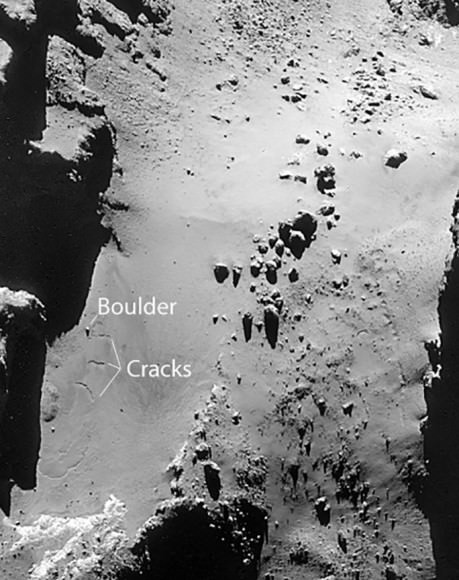
Recent photos taken by the Rosetta spacecraft reveal possible changes on the surface of 67P/Churyumov-Gerasimenko that are fascinating to see and contemplate. In a recent entry of the Rosetta blog, the writer makes mention of horseshoe-shaped features in the smooth neck region of the comet called “Hapi”. An earlier image from Jan. 8 may show subtle changes in the region compared to a more recent image from Jan. 22. We’ll get to those in a minute, but there may be examples of more vivid changes.
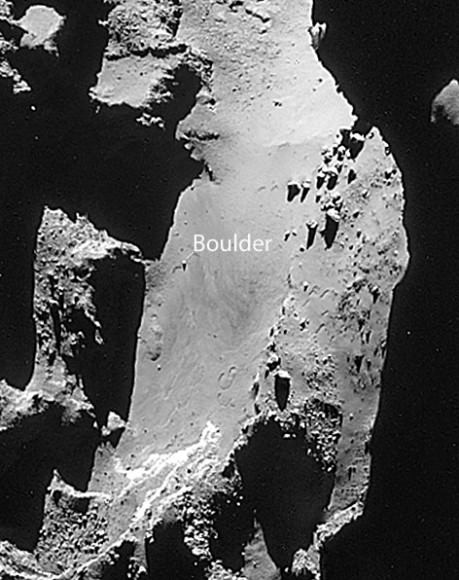
I did some digging around and found what appears to be variations in terrain between photos of the same Hapi region on Dec. 9 and Jan.8. Just as the other writer took care to mention, viewing angle and lighting are not identical in the images. That has to be taken into account when deciding whether a change in a feature is real or due to change in lighting or perspective.
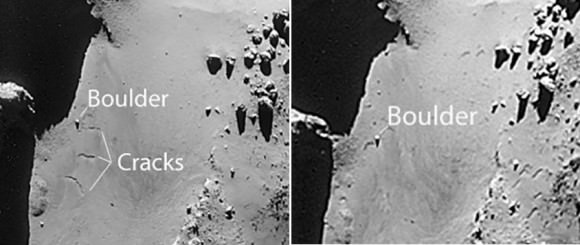
But take a look at those cracks in the December image that appear to be missing in January’s. The change, if real, is dramatic. If they did disappear, how? Are they buried in dust released by jets that later drifted back down to the surface?
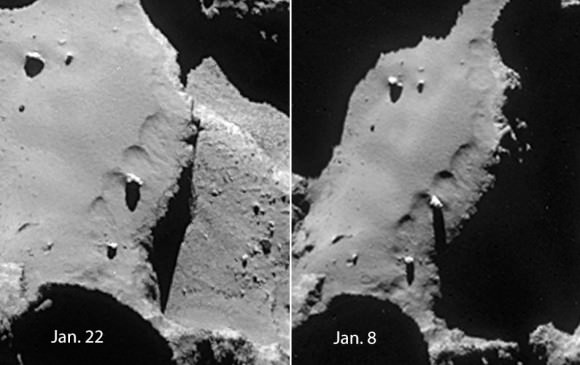
Now back to those horseshoe features. Again, the viewing angles are somewhat different, but I can’t see any notable changes in the scene. Perhaps you can. While comets are expected to change, it’s exciting when it seems to be happening right before your eyes.
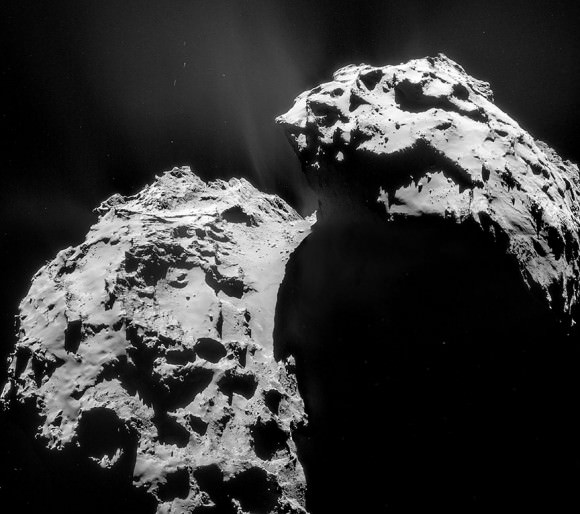

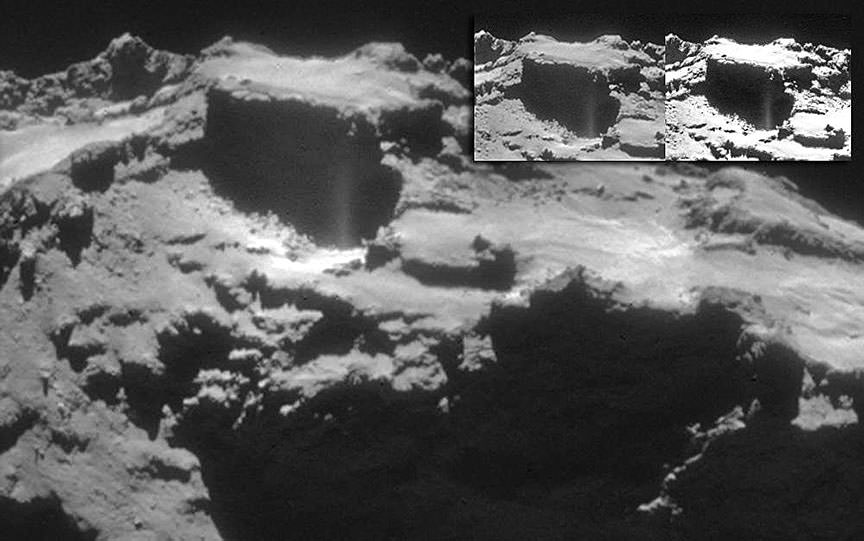
Thank You Bob for this piece. Just looking at the higher resolution pics leaves me in awe, gawking and finding it hard to swallow when we realize that this is real, happening in front of us.
And we’re not at perihelion yet!!
Just wanted to put a friendly wager of 50 Quatloos on jets’ activity being directly proportionate to the core (or cores?) internal temperature, influenced by the 2nd axis of rotation or precession.
🙂
BC,
I’ll up you to 100 Quatloos and if you’re wrong you’ll have to battle one of the thralls of Triskelion. Fair enough? Frankly though, I think you have something there since the jets appear to be coming from below the surface.
Fair enough but unless the thralls are the kind that fraternized with Capt. Kirk, we’ll need to have a talk on the meaning of the word “friendly” 😉
What a load of rubbish. You guys have some vague (wrong) assumptions about how a comet works, based on falsified theories on what a comet actually is, every close up observation over the past 10, 15 years was an embarresment for your models, and now you want to prove your rubbish models with this; some shifted sand, a shadow and a lense flare!?
what in the heck are you talking about? All they say in the article is that the sun heats the ice on the comet which changes things and creates jets..
so what is the theory that you subscribe to? What do you think a comet “actually is?
I do not see any claims of proof here only report of observations from a European probe so I’m not sure what you’re getting all negative on Bob.
What’s the “wrong” part? Did I miss something?
Models change, they evolve. that’s THE thing in Science. “We” do not stop investigating when a model is presented, we just keep asking more questions. If you have a better alternative to doing sciences to find out what’s true and real, please let us all know.
For the time being, we have a front row seat bolted to Rosetta, orbiting a sizable chunk of exotic ices, on a trajectory that will warm the comet for the untold time and bring it to a level of activity that only lasts a few weeks. “We”‘re in for the ride of our lives. If you can’t appreciate the beauty of our Solar System, perhaps you’ll enjoy this little morale booster:
http://youtu.be/zv7v4MJcD74
🙂
Don’t feed the troll, fellows.
While comets are expected to change, it’s exciting when it seems to be happening right before your eyes.
Hear, hear.
Do we yet have any good images of how the comet looks like from outside the coma? You know, a “typical” photo of a comet.
Here is an image of 67P/Churyumov-Gerasimenko taken with one of the 8 meter VLT ‘scopes back in August 2014: https://www.eso.org/public/images/potw1436a/
IIRC the comet was around magnitude 18 or 19 at the time.
Thanks.
If Rosetta was located within a pixel in that photo, I can’t imagine what it would be like today (or perhaps too excited to imagine). Yet the more recent images from the probe itself seem to suggest that it’s witnessing a light-show and gentle dancing fountains. 😀
Thanks Jon… I hope to get a look at 67P with my ‘new’ 12 1/2″ Newt… eventually! MAYBE even some images?
From NASA: “Although the comet will not get bright enough to be seen with the naked eye, small telescopes will be able to detect it in 2015, and there are opportunities for amateur astronomers to join the campaign too.”
Looking at your Dec 9th/Jan 8th comparison images, you’re right, it does look as though the cracks have virtually disappeared. But am I the only one who noticed the new cracks on the higher ground to the right-hand side of the Jan 8th image? There looks to be five shorter, roughly parallel cracks running bottom left to top right in the open area on that raised ground. I submit that these cracks and their changes might be caused by subsidence in the underlying material under the dust.